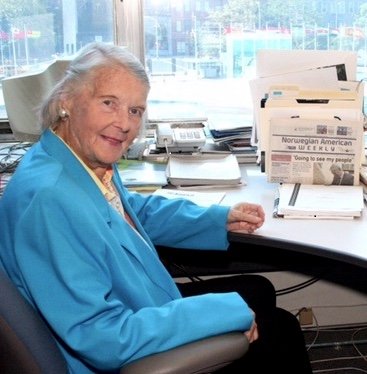By Rigmor Swensen and Rolf Stang
Else Hvistendahl Levering passed away just before Christmas 2015 at 96 years of age. The American Scandinavian community knows her as a journalist—a woman of words that have made so many events come alive for wide and varied audiences.
Some call Else “a steel cup cake”— always gracious and unassuming, but wielding a pen that was spot on. Else was born in Kristiania (renamed Oslo in 1925) May 2, 1919. When Hitler invaded Norway, she fled to Malmø, Sweden to neutral Portugal and traveled by steamship landing in New York in December 1940.
After completing a B.A. degree at Smith College, she took a job in New York City working for the U.S. government in the Department of War Information, becoming Assistant Language Editor. World War II was in full vigor and Else translated a running stream of news dispatches into Norwegian. These communiqués were also included in supply parcels, sometimes including recipes Else translated, that were dropped behind enemy lines.
Nordisk Tidende, now the Norwegian American Weekly, asked for a weekly column about Else’s life at Smith. That was the time the young writer found a calling to write about people.
Nordisk Tidende was entirely published in Norwegian until 1991, and Hvistendahl’s first Nordisk Tidende article was published in the Norwegian weekly magazine, Alle Kvinner, an act that established her long association with Norwegian publications. Else began writing for Aftenposten, Norway’s largest newspaper in 1954 (and still today), and became its United Nations correspondent. Else chose to be a freelancer to have flexibility of time to spend in New York and in Norway and to have a choice of assignments. As you read this abbreviated account of her work, you will, I’m sure, reflect on some of the most famous, and some of the most notorious personalities of the second half of the 20th century. Once, when asked how she was able to reach and talk with so many with so many important international figures she replied: “Quite honestly, nothing seems ever to have come easily. I do what I know how to do, but it’s consistent hard work that has made things happen for me.”
In an interview with her long-time friend Rolf Stang, Else observed that most of her interviews had taken place in New York. “New York is a remarkable crossroads; sooner or later everybody comes this way, if they don’t already live here. Only in New York, they say. Most of the time, too, I find the busier and more accomplished the persons, the nicer they are.”
The NIA looks forward to collecting and preserving complete versions of many of her interviews. Here’s a taste of forthcoming articles which we hope will tempt you to keep checking our website niahistory.org for interviews as we find them.
- Dr. Jonas Salk’s mother—(life as mother the doctor who discovered the polio vaccine)
- Princess Yasmin Aga Kahn—(about her mother Rita, Hayworth’s alzheimers)
- Actress Patricia Neal—wife of Norwegian born Roald Dahl and survivor of several strokes)
- Mother Hale—cared for children in need
- Steffi Graff—Tennis star
- Earl Hyman—influenced as an actor by Ibsen’s plays (learned to speak Norwegian)
- Anne Marie Rockefeller—Cinderella Story
- Kristin Holby—famous Ralph Lauren model, known as Clothilde)
- Kari Widad Shihabi—wife of former UN General Assembly president
- Ragnar Ulfung—opera singer
- Salvador Dali—her most difficult interview (conducted in French).
Else Hvistendahl lived in New York City and maintained a summer home in Hankø, Norway. Her first husband, was the leading attorney Paul DeWitt with whom she had a son, Jon. Her second husband of twenty plus years, was financier and sailor Walter B. Levering.

